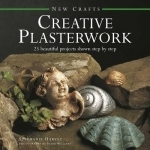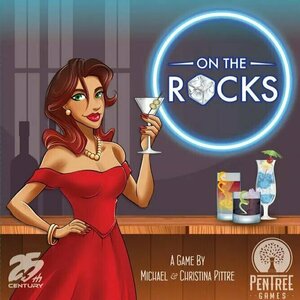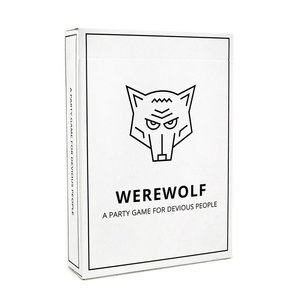Purple Phoenix Games (2266 KP) rated On the Rocks in Tabletop Games
Sep 7, 2021
“On the Rocks is a marble drafting, cocktail recipe fulfillment game for 1-4 players. It is NOT a drinking game.” – straight from the game’s BGG page. So what does that mean? Well, this one is a variation of the “I cut, you choose” style game, but HEAVILY themed around bartending and enhanced with additional fun mechanics. The winner is the player who amasses the most amount of money by the end of their shift.
DISCLAIMER: We were provided a copy of this game for the purposes of this review. This is a retail copy of the game, so what you see in these photos is exactly what would be received in your box. I do not intend to cover every single rule included in the rulebook, but will describe the overall game flow and major rule set so that our readers may get a sense of how the game plays. For more in depth rules, you may purchase a copy online or from your FLGS. -T
To setup, consult the rulebook, as there are many steps. However, once setup, the game should look similar to the photo below. Choose the starting player and the mixology competition can begin!
On the Rocks is played over several rounds with each player completing specific steps. The first step is optional, and is Tip Cards. Players will accumulate Tip Cards throughout the game, and each one features a special ability that may be used at this time. The next step may also be optional, depending on if the active player had received a Complaint card previously. Complaints must be completed on this step and is pretty much a wrench thrown in the plans by competitors.
Once these (possibly) optional steps have been completed the active player then takes the 2d6 and Rolls them. This number determines how many ingredient marbles are to be pulled from the bag and added into play. For the cost of one ingredient marble, the active player may manipulate the rolled dice by flipping it to its opposite face. Next, the player will Draft the number of marbles from the bag they rolled in the previous step. From these drafted marbles the player will Mix them into the blue Jigger Bowls in the middle of the table one at a time, a la Mancala (oh that’s fun to say: A LA MANCALA!). Then the player will Select & Place a jigger of marbles from the table onto their player board. Placing the corresponding marbles onto the drinks is how recipes can be completed. If any ingredients were selected from the jigger but not placed, the player must then place the ingredients into the Extra Ingredients shot glasses on the top portion of the player board, to Save for later use.
When the ingredient marbles have been placed and saved, the player must then complete the Resolve step. Several ingredient marbles are “Premium” or “Spill” marbles. Premium marbles (golden) allow the player to select ANY two ingredients from the draw bag and the Premium marble is then discarded to the coaster in the middle of the table. The black Spill marble forces the active player to draw a Spill card from the deck and complete its action. It also during the Resolve step that the player may complete a recipe card by discarding the drink’s ingredients to the bag and flipping its recipe card face-down. If the entire order (all of the face-up recipe cards) is completed, the active player’s round ends and they notate this by placing one of the three lemon tokens on their player board. Some round end cleanup is performed, like drawing another set of 3 or 4 drink recipes for an order, and the player’s turn is over.
Once a player has completed their third order of drinks, they must indicate “Last Call” to the other players at the table. This informs the other players that they have one last turn to earn any extra money before the game ends. When the game has been finished, final scoring is performed and the winner is they who earned the most money throughout the night. The other players must immediately fix the winner a drink, or buy the winner a shot. Okay, those aren’t in the rulebook, but merely suggestions for the revised second edition…
Components. For those that follow our reviews, you know I am a sucker for games with great components, and this one definitely delivers for me. The aesthetics and art style are just perfect, the double-layer boards are always lovely, and the rubber jiggers are excellent. I cannot see anything that can be improved in terms of components, and I completely expected that because this was published by Pentree Games and 25th Century Games (one of my favorite publishers in the business). The game looks and feels deluxe, which is VERY satisfying.
I think that the Pittre duo of Michael and Christina really knocked it out of the park with this one. Wait, this is their first game design?? And it’s incredible? Okay okay, I’ll be keeping my eye on you two. On the Rocks is a light game with excellent table presence and some difficult choices presented. Now, the choices may be TOOOOOO difficult for some gamers, especially our AP-prone players. Carefully planning out each ingredient’s distribution into the jigger bowls can send them into a frenzy, so I have advised to choose one or two bowls they wish to buff and concentrate on hitting those with the marbles they want, and just randomly place the other ingredients. I know that is a big ask, but this game is supposed to take 45-90 minutes, not 45-90 hours. My other gripe about the game is the color-dependence of the ingredient marbles. I am sorry to all my colorblind friends out there, but I am unable to see how you might keep a possible 12 different marbles straight in your heads while simultaneously remembering the state of marbles in each jigger bowl. I hope I am completely wrong, as I do not suffer from colorblindness, and please do let me know if this is still playable for those gamers.
These gripes aside, everything else about the game is fabulous. I love being able to manipulate my dice rolls (yes, with a cost) to have ultimate control of the number of marbles pulled from the bag. That bag, however, takes control away immediately unless I draft a bunch of clear (wild) or golden marbles to affect my final placements. I also adore struggling to choose which recipes to concentrate on first, and weighing the possibilities of completing the higher value recipes, or blitzing the smaller ones first.
Oh, and the Spills cards? They can be real pains in the booty. These effectively give the active player the ability to completely botch another players’ plans by discarding their ingredient marbles from their player board. Not enough player interaction? How about negative Tip cards, which are earned by completing a recipe, that impede a competitor’s progress by making them complete the Tip card before being able to move on with their plans, or by limiting their marble selection to two instead of the entire bowl? Yeah, this has player interaction for sure.
Again, I like a good drink now and then, just as much as the next person. However, I have never been a bartender, and I do not plan on ever becoming one. I could not ever imagine having to compete with other bartenders for tip money either, especially if it is as brutally cutthroat as On the Rocks portrays it to be. I will, however, play a game where all that “fun” is diluted to dice, cards, and marbles. I was looking through my collection recently and noticed have embarrassingly few games with an adult beverage theme. If you are like me and require more games depicting fun with alcohol, then I strongly urge you to check out On the Rocks. I feel like I can finally graduate from Fuzzy Navels and Stone Sours just by playing this game and really upping my liquor acumen. Purple Phoenix Games gives this one a delicious 5 / 6. It seems readily available for consumption, but please do not try to go drink for drink with this game. It’s not designed to be a drinking game… or is it?
Purple Phoenix Games (2266 KP) rated Werewolf: A Party Game for Devious People in Tabletop Games
Jun 24, 2021
Disclaimer: We were provided with a copy of this game for the purposes for this review. What you see is a finalized production copy, and is what would be received in a retail copy. -L
Werewolf: A Party Game for Devious People (simply referred to as Werewolf from here on out), is a game of bluffing and deduction in which players are attempting to complete their objective, based on their secret roles. Werewolves are trying to outnumber the Villagers, and Villagers are trying to kill all the Werewolves. To setup for a game, assemble the deck of role cards. Each deck will always have 1 Moderator card, a number of Werewolf cards, and a number of Villager cards depended on the player count. For example, a 5-player game would have 1 Moderator, 1 Werewolf, and 3 Villagers. Each player is dealt one card and keeps their role a secret, except the Moderator. The game is now ready to begin.
Each round consists of a Night and Day phase, all facilitated by the Moderator. To start the Night phase, all players (except for the Moderator) will close their eyes. The Moderator prompts the Werewolf to awaken (open eyes) and silently point to a Villager to kill. The Werewolf then closes their eyes, and the Night phase ends. To start the Day phase, the Moderator will have all players open their eyes, and will reveal which player has been killed in the night. All remaining ‘living’ players now have a chance to discuss amongst themselves and try to figure out the identity of the Werewolf. Accused players have a chance to defend themselves, and may even throw the blame to other players. Once players reach a consensus, they will kill off the accused Werewolf. If the accused player was the Werewolf, then the Villagers win (in a 5-player game)! If the accused player was not the Werewolf, then a new round begins with a Night phase, and the Werewolf is one step closer to winning. The game ends when either the Villagers have killed the Werewolf, or the Werewolf equals or outnumbers the Villagers.
The above description is a generic rundown of the game. Many versions of Werewolf have additional roles/abilities to enhance the gameplay and add new elements to the strategy. This particular version of Werewolf does indeed include optional additional roles. Those roles are: Seer, Doctor, Drunk, Witch, and Alpha Werewolf. These optional roles grant players additional abilities/powers for use during play. For example, every Night phase, the Seer can silently ask the Moderator whether a single player is a Werewolf or not. That can definitely help in the Day phase when it is time to accuse people! The addition of these roles helps to enhance the strategic gameplay by offering more for players to do, rather than just blindly accuse and guess each round. Included in the tuck box are even some blank role cards for you to create your own roles/powers if you so choose.
The major downside to any version of Werewolf is that once a player has been killed off, if they were not the Werewolf, they are out of the game for good. So even if the game lasts for 20 more minutes, that player just has to sit there in silence.
Components. This particular Werewolf consists of a deck of role cards, rules, and a guide for the Moderator. The quality of the cards is nice, and they are easy to manipulate and are sturdy. The artwork is very minimalistic in this game, and it actually works pretty well since Werewolf really isn’t a component-based game. All in all, a good quality deck of cards.
Overall, this is just a normal game of Werewolf. Honestly, you don’t really even need any components to play – as long as everyone knows the rules and roles, you are good to go. Does having a deck of cards help? In some ways, yes. But it kind of just feels redundant to me, since I already knew how to play the game. If you’re wanting to introduce someone to the Werewolf-type game, this little deck of cards would be a good way to do it. Personally, this type of game appealed to me more as a child/teen, and it kind of falls flat to me now as an adult, thus my low score. I don’t see this game staying in my collection forever, but it had a decent run while it was here. Purple Phoenix Games gives it a calculated 4 / 12. If you’ve played any variation of Werewolf before, there’s really no need to check out this particular iteration.

Literary Legends of the British Isles: The Lives & Burial Places of 50 Great Writers
Book
Journey into the best of British Isles literati in this comprehensive and concise review of 50 of...
Authentic and Inauthentic Places in Tourism: From Heritage Sites to Theme Parks
Book
With the rise of post-truth and fake news, a thorough examination of authenticity has never been so...

Ivory, Apes & Peacocks: Animals, Adventure and Discovery in the Wild Places of Africa
Book
Alan Root is one of the great wildlife pioneers. His unmatched experience of East African wildlife...

New Crafts: Creative Plasterwork: 25 Beautiful Projects Shown Step by Step
Book
Few craft materials are cheaper to buy or easier to work with than plaster, and by mastering and...

Only in Prague: Guide to Hidden Corners, Little-Known Places & Unusual Objects
Book
Discover Europe with the 'Only In' Guides! These ground breaking city guides are for independent...





